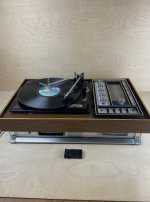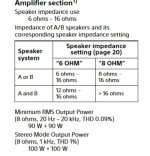JDBarrow
Member
- Thread Author
- #1
This is to improve Samsung smart television sound, set-top PC sound, Panasonic DVD/Blu-Ray sound and play hi-fi music streamed from telephone by Bluetooth.
I ordered the following from amazon so far:
Sony STRDH190 2-ch Home Stereo Receiver with Phono Inputs & Bluetooth Black
Amplify and enjoy your home audio experience in the comfort of your home.
Frequency band : 2,400 MHz – 2,483.5 MHz, Maximum output power : ≤ 5.0 dBm..Connector Type: Bluetooth
100 watts x 2 (8 ohms, 1 Kilo Hertz). Speaker impedance - 6–16 ohms
Phono input, 4 stereo RCA audio inputs, 3.5 millimeter input, stereo RCA output
Built in Bluetooth lets you wirelessly stream your favorite music service, podcasts, and more from other Bluetooth devices.
Connect up to 4 speakers; A/B switching to play all at once, or in separate zones
Low profile design (5 ¼ Inch tall) fits easily into conventional AV cabinet
FM Radio with 30 station presets; Full size (1/4 inch) headphone jack
Enjoy the subtlest nuances of studio-quality sound in higher than CD quality with High-Resolution Audio. Passion for music unites every component from signal to speaker so it feels like the artist is performing right in front of you.
In the box: Remote (RMT-AA400U), batteries, FM antenna
Large capacity power transformer built for clarity : Care and attention to the highest quality audio starts with the power transformer.
Dayton Audio T652 Dual 6-1/2" Woofers and 5/8" Dome Tweeter 2-Way Tower Speaker Pair - 30" Inches Tall - 90 Watts RMS, 150 Watts Max, 6 Ohms Impedance (4 to 8 Ohms Compatible)
Maximum watts and impedance: The Dayton Audio T652 Dual 6-1/2" Woofers and 5/8" Dome Tweeter 2-Way Tower Speaker Pair have a maximum power handling of 90 watts per speaker and an impedance of 6 ohms, ensuring compatibility with a wide range of stereo receivers and amplifiers.
Stereo speakers for home audio: The T652 tower speakers deliver impressive stereo sound for music and movies, making them an excellent choice for home audio systems and creating an immersive listening experience with their powerful performance and sleek design.
Home theater speakers: With their dual 6-1/2" woofers and 5/8" dome tweeter, the T652 speakers provide clear and dynamic audio reproduction, making them ideal home theater speakers that enhance the audio experience for movies, TV shows, and other multimedia content.
Tower speakers for versatile placement: The slim and tall design of the T652 tower speakers allows for easy placement in various room configurations, making them suitable for both small and large spaces while maintaining a stylish and modern aesthetic.
Backed By Our Famous Risk-Free Purchase - Not only does your Dayton Audio T652 Dual 6-1/2" Woofers and 5/8" Dome Tweeter 2-Way Tower Speaker Pair come with an exclusive 5-year warranty, but you’ll get our comprehensive spec guide
Wired speakers for stereo systems: The Dayton Audio T652 speakers come with speaker wire terminals that support secure connections to stereo receivers or amplifiers, ensuring reliable and high-quality audio performance from your wired home audio system.
I ordered the following from amazon so far:
Sony STRDH190 2-ch Home Stereo Receiver with Phono Inputs & Bluetooth Black
Amplify and enjoy your home audio experience in the comfort of your home.
Frequency band : 2,400 MHz – 2,483.5 MHz, Maximum output power : ≤ 5.0 dBm..Connector Type: Bluetooth
100 watts x 2 (8 ohms, 1 Kilo Hertz). Speaker impedance - 6–16 ohms
Phono input, 4 stereo RCA audio inputs, 3.5 millimeter input, stereo RCA output
Built in Bluetooth lets you wirelessly stream your favorite music service, podcasts, and more from other Bluetooth devices.
Connect up to 4 speakers; A/B switching to play all at once, or in separate zones
Low profile design (5 ¼ Inch tall) fits easily into conventional AV cabinet
FM Radio with 30 station presets; Full size (1/4 inch) headphone jack
Enjoy the subtlest nuances of studio-quality sound in higher than CD quality with High-Resolution Audio. Passion for music unites every component from signal to speaker so it feels like the artist is performing right in front of you.
In the box: Remote (RMT-AA400U), batteries, FM antenna
Large capacity power transformer built for clarity : Care and attention to the highest quality audio starts with the power transformer.
Dayton Audio T652 Dual 6-1/2" Woofers and 5/8" Dome Tweeter 2-Way Tower Speaker Pair - 30" Inches Tall - 90 Watts RMS, 150 Watts Max, 6 Ohms Impedance (4 to 8 Ohms Compatible)
Maximum watts and impedance: The Dayton Audio T652 Dual 6-1/2" Woofers and 5/8" Dome Tweeter 2-Way Tower Speaker Pair have a maximum power handling of 90 watts per speaker and an impedance of 6 ohms, ensuring compatibility with a wide range of stereo receivers and amplifiers.
Stereo speakers for home audio: The T652 tower speakers deliver impressive stereo sound for music and movies, making them an excellent choice for home audio systems and creating an immersive listening experience with their powerful performance and sleek design.
Home theater speakers: With their dual 6-1/2" woofers and 5/8" dome tweeter, the T652 speakers provide clear and dynamic audio reproduction, making them ideal home theater speakers that enhance the audio experience for movies, TV shows, and other multimedia content.
Tower speakers for versatile placement: The slim and tall design of the T652 tower speakers allows for easy placement in various room configurations, making them suitable for both small and large spaces while maintaining a stylish and modern aesthetic.
Backed By Our Famous Risk-Free Purchase - Not only does your Dayton Audio T652 Dual 6-1/2" Woofers and 5/8" Dome Tweeter 2-Way Tower Speaker Pair come with an exclusive 5-year warranty, but you’ll get our comprehensive spec guide
Wired speakers for stereo systems: The Dayton Audio T652 speakers come with speaker wire terminals that support secure connections to stereo receivers or amplifiers, ensuring reliable and high-quality audio performance from your wired home audio system.


